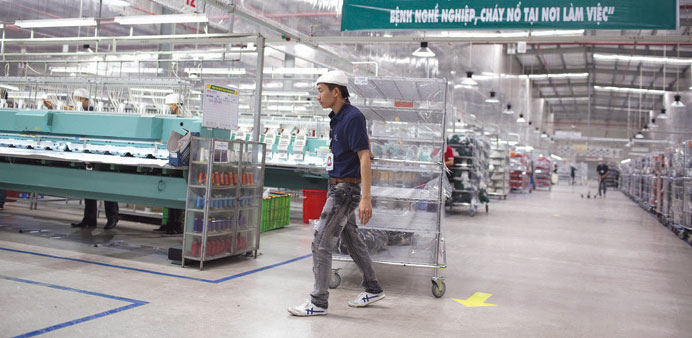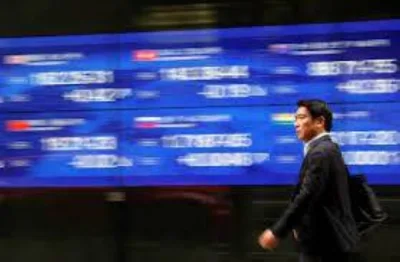A worker pulls a trolley past embroidery machines inside a garment factory at the Vietnam-Singapore Industrial Park in Binh Duong province. According to PricewaterhouseCoopers, the country has the potential to become one of the world’s fastest-growing economies over the period to 2050.
Bloomberg/Hanoi
Perched along one of the world’s most crucial shipping routes, and with a young and growing population, Vietnam is – once again – being tipped for economic lift-off, after years of disappointment.
Money pouring into the Southeast Asian economy from the likes of manufacturers Samsung Electronics and Intel Corp is giving Vietnam a second run at becoming Asia’s next tiger economy. The country’s “Doi Moi” market opening in the 1980s ushered in spurts of growth in excess of 7% that waned in recent years after a pile-up of bad debt at state-owned enterprises.
According to PricewaterhouseCoopers, the country has the potential to become one of the world’s fastest-growing economies over the period to 2050. Not only is the Southeast Asian nation gaining ground as a cheaper manufacturing alternative to neighbouring China, Vietnam is also a politically palatable destination for Japanese firms boosting investment in the region amid recurring Sino-Japan spats.
“It is quite possible that Vietnam could become the fastest-growing economy in Asia,” said Vikram Nehru, a senior associate in the Asia Programme and Bakrie Chair in Southeast Asian Studies at the Carnegie Endowment for International Peace in Washington. “It has all the ingredients for rapid growth if it can address the challenges in the state sector.” Signs of Vietnam’s growing clout are gathering: In 2014 the country overtook regional counterparts to become the biggest exporter to the US from the Association of Southeast Asian Nations, or Asean, muscling ahead of its more established manufacturing rivals of Thailand and Malaysia.
Disbursed foreign investment in Vietnam has soared in the past 14 years to reach $12.35bn in 2014, up 7.4% from 2013 and compared with $2.4bn in 2000, figures from the Foreign Investment Agency show. Samsung’s operations in the country are growing so big that it got government approval to operate its own terminal at Hanoi’s Noi Bai International Airport.
And manufacturers are shifting from China. Japanese printer maker Kyocera Document Solutions Inc, a unit of Kyocera Corp, plans to quadruple its annual printer production in Vietnam to 2mn units by March 2018, the company said this month. Part of its operation in China will be moved to Hai Phong, making Vietnam the company’s biggest manufacturing base for printers, with another plant planned by August, it said.
“Vietnam is really the big winner from China losing its competitiveness because of rising wages” and a strong currency, said Frederic Neumann, co-head of Asian economics research in Hong Kong at HSBC Holdings. “By moving very early into the space vacated by China, Vietnam has first-mover advantage and it is now starting to show.” Before weakening last year, the yuan in Shanghai had a four-year advance of 13% that was the best performance among 24 emerging-market currencies tracked by Bloomberg. Vietnam’s benchmark stock index has climbed 5.5% this year, compared with Indonesia’s 4.1% increase, Malaysia’s 2.4% and Thailand’s 2.2%. Vietnam’s annual real gross domestic product growth could average 5.3% in the 2014-50 period, a pace only bettered by Nigeria, according to PwC’s “The World in 2050” report. Growth in China may fall below 4%.
Demographics are a big help. Some 13% of China’s population in 2012 was already 60 or older, compared with 9% in Vietnam, according to the UN. More than 40% of Vietnam’s population of about 90mn in 2013 was in the labor force aged 15 to 49, government data show.
The average monthly wage in Vietnam was $197 in 2013 compared with $391 for Thailand and $613 for China, according to International Labour Organisation calculations. That disparity is widening. The Economist Intelligence Unit predicts that in 2019, manufacturing labour costs per hour in China will be 177% of those in Vietnam, up from 147% in 2012.
“I remember when I was in China a couple of years ago and went to buy a pair of shoes and found they were all made in Vietnam,” said John Hawksworth, one of the authors of the PwC report.
There are caveats to the optimism.
Lenders in Vietnam are creaking under bad loans, and the government has struggled to overhaul inefficient state-owned companies. Inadequate infrastructure, skills gaps and corruption remain risks. Vietnam ranked 119 out of 175 countries and territories in the Berlin-based Transparency International’s 2014 Corruption Perceptions Index.
China came in at 100th place. Meanwhile, other Southeast Asian countries such as the Philippines and Malaysia are also competing to win manufacturing jobs.
“It’s not guaranteed that Vietnam will fulfil its potential,” said Hawksworth. “Part of it is that Vietnam is simply in a good geographic location and part of it is that it does have some catching up to do in terms of GDP per capita.”



